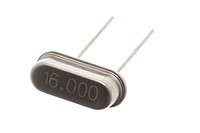
Photo from wikipedia
Highly stable on-chip frequency references offer the possibility of replacing crystal oscillators in many cost-and form-factor-constrained applications. However, achieving good frequency stability in a power-efficient manner across process, voltage, and… Click to show full abstract
Highly stable on-chip frequency references offer the possibility of replacing crystal oscillators in many cost-and form-factor-constrained applications. However, achieving good frequency stability in a power-efficient manner across process, voltage, and temperature variations possess many design challenges. This article describes these challenges and presents a method for improving the integrated RC oscillator’s frequency accuracy by overcoming them. We show that the impact of resistor temperature coefficient (TC) on the accuracy of output frequency can be mitigated by using a parallel combination of two switched resistors that are digitally controlled by pulse-density modulated sequences. By trimming at only two temperatures, a prototype frequency-locked loop (FLL)-based 32-MHz oscillator fabricated in a 65-nm CMOS process achieves an inaccuracy of 530 ppm (8.4 ppm/°C), 80-ppm/V voltage sensitivity, 2.5-ppm Allan deviation, and 1- $\mu \text{W}$ /MHz power efficiency.
Journal Title: IEEE Journal of Solid-State Circuits
Year Published: 2022
Link to full text (if available)
Share on Social Media: Sign Up to like & get
recommendations!